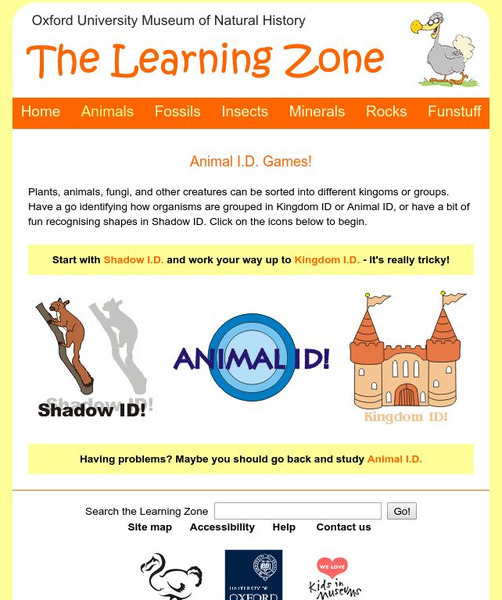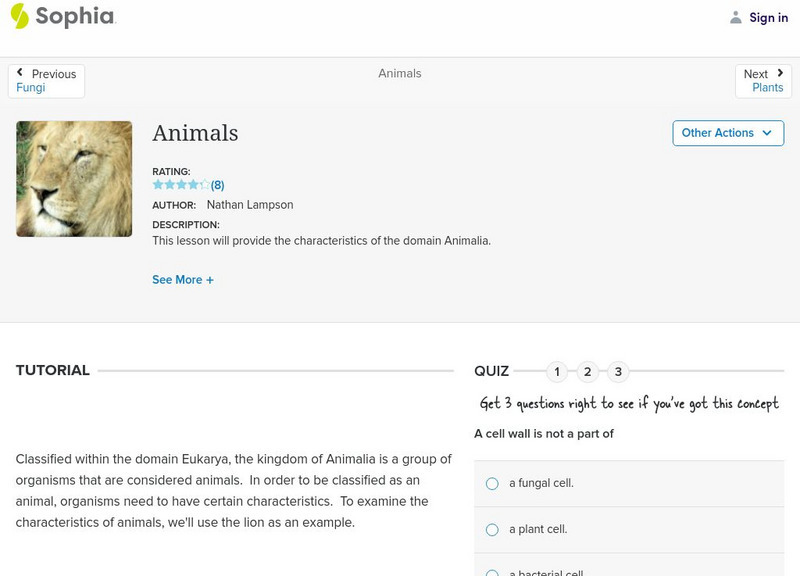Scholastic
Scholastic: Study Jams! Science: Animals: Kingdoms of Life
A playful interactive introducing biology's five animal kingdoms. Watch the video, take a quiz, and review vocabulary.
Untamed Science
Untamed Science: Biodiversity: Animals: Kingdom Animalia
Learn about the characteristics that make Kingdom Animalia a distinct classification group. Explore photos and watch video clips about many species of animals.
Other
The Animals Page
Provides an easy to understand overview of animals from protozoa and echinoderms to insects, mammals, birds, and fish.
Morning Earth
Biosphere Community: Kingdom Animals
Students examine the biology topic of kingdom animals. The tutorial includes definitions, examples, and pictures.
Regents of the University of Michigan
Animal Diversity Web: Kingdom Animalia
What characterizes animals from plants? General characteristics of the animal kingdom are noted here. Click on Classification for the Kingdom Animalia; clicking on the camera provides pictures of each animal.
University College London
Univ. College London: Digital Egypt: Burial Customs From Late Middle Kingdom
An examination of the types of burial goods found in burial chambers from the Middle Kingdom. Click on the pictures to take you to more pictures and some explanation. Hyperlinks to other articles on this complex website.
Globio
Glossopedia: Animals
The animal kingdom and its classification are explained and broken down into vertebrates and invertebrates in this resource. "Best-of" the animal kingdom list given - fastest, smallest, largest, strongest and more.
Mocomi & Anibrain Digital Technologies
Mocomi: Kingdom Classification of Living Organisms
Learn about who created the classification of living things, how they are classified, and the six different kingdoms.
University of Oxford (UK)
Oxford University of Modern History: Animals
Plants, animals, fungi, and other creatures can be sorted into different kingoms or groups. Have a go identifying how organisms are grouped in Kingdom ID or Animal ID, or have a bit of fun recognising shapes in Shadow ID. Click on the...
Other
University of Aberdeen: The Phyla of Kingdom Animalia
Very systematic breakdown of the animal kingdom starting with the simplest type the sponge, all the way to the chordate or vertebrate. Each phylum has a link with information.
Untamed Science
Untamed Science: Biodiversity: Animals: Invertebrates
See all the of the different animal phyla that represent invertebrates and how diverse they are with the help of short video clips.
English Club
English Club: Vocabulary: Cloze Games: Animals Cloze 10
Choose from a word bank to complete ten sentences about animal kingdoms. Hints are available if needed, and a percentage score is displayed once answers are submitted.
Wisc-Online
Wisc Online: The Fungi Kingdom
What are some of the common characteristics of fungi? How do they differ from plants and animals? You will find the answers to these questions and more on this brief but informative site.
Sophia Learning
Sophia: Animals
This lesson will provide the characteristics of the kingdom Animalia.
Other
Secondary Science Program: The Six Kingdoms
A short overview of the six kingdoms in our scientific classification system: Plants, Animals, Protists, Fungi, Archaebacteria, and Eubacteria.
Wikimedia
Wikipedia: Protist
Wikipedia provides information on the biological kingdom protista, including a list of different divisions of the kingdom.
Untamed Science
Untamed Science: Biodiversity: Animals: Chordates: Amphibians: Class Amphibia
Explore the biodiversity of the Class Amphibia through videos, photos and examples. [2:34]
Untamed Science
Untamed Science: Biodiversity: Animals: Chordates: Birds: Class Birds
Through video clips and pictures, explore the orders and a variety of species found in the Class Aves.
Globio
Glossopedia: Plants
Plants are one of the two major Kingdoms of living creatures on the Earth. They are the only beings which produce their own food. Additionally, plants are necessary for animals to live. Plant anatomy, life cycle, reproduction and the...
CK-12 Foundation
Ck 12: Episd: Animal Characteristics
[Free Registration/Login may be required to access all resource tools.] Students will be able to identify and classify organisms that are animals based on recognition of traits presented.
Other
Colchester Zoo, England
This is the homepage of the Colchester Zoo in Colchester, England. There is information about the zoo and the animals. There is a virtual tour and there are real player and QuickTime videos under the "Display and Feeding Times" category.
Colorado State University
Colorado State University Libraries: Garst [Wildlife] Photographic Collection
Digitized collection, searchable by name, endangered species status, habitat, or continent, of over thirteen hundred wildlife photographs taken throughout the world during the filming of Mutual of Omaha's Wild Kingdom television series....
Curated OER
Secondary Science Program: The Six Kingdoms
A short overview of the six kingdoms in our scientific classification system: Plants, Animals, Protists, Fungi, Archaebacteria, and Eubacteria. A good explanation of how organisms are placed in their particular kingdom.
Curated OER
Secondary Science Program: The Six Kingdoms
A short overview of the six kingdoms in our scientific classification system: Plants, Animals, Protists, Fungi, Archaebacteria, and Eubacteria. A good explanation of how organisms are placed in their particular kingdom.


















![Colorado State University Libraries: Garst [Wildlife] Photographic Collection Website Colorado State University Libraries: Garst [Wildlife] Photographic Collection Website](https://content.lessonplanet.com/knovation/original/209361-4b7da185aee2c7b0cebc49579baf904c.jpg?1661495039)